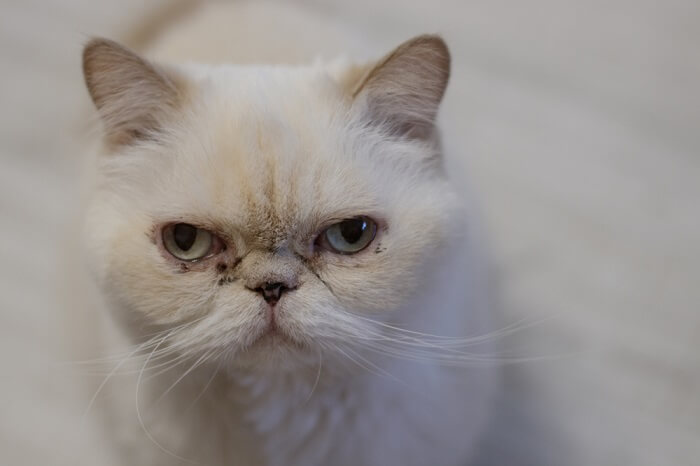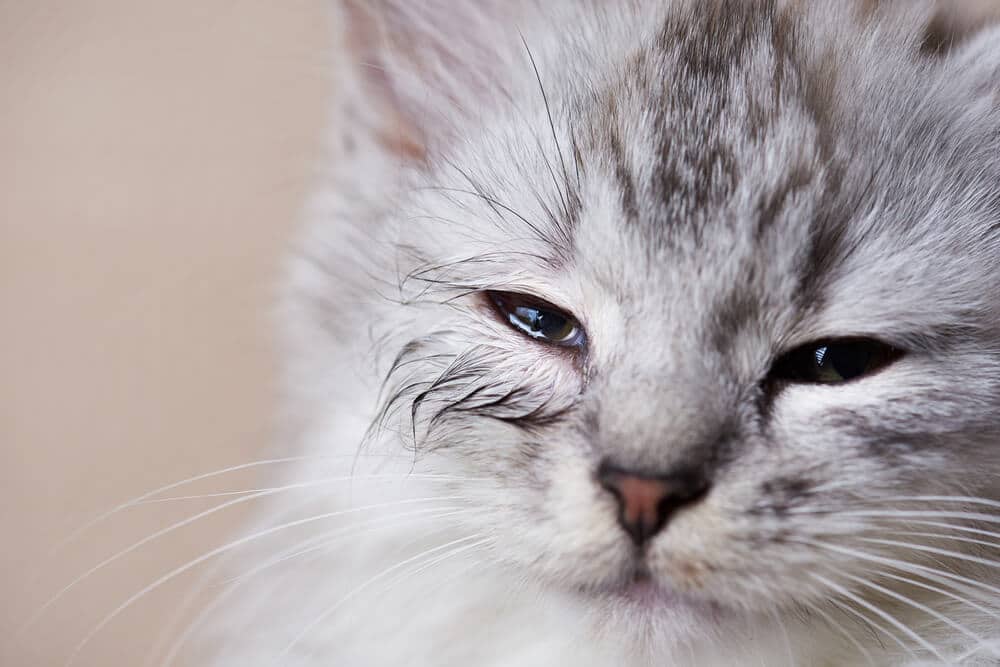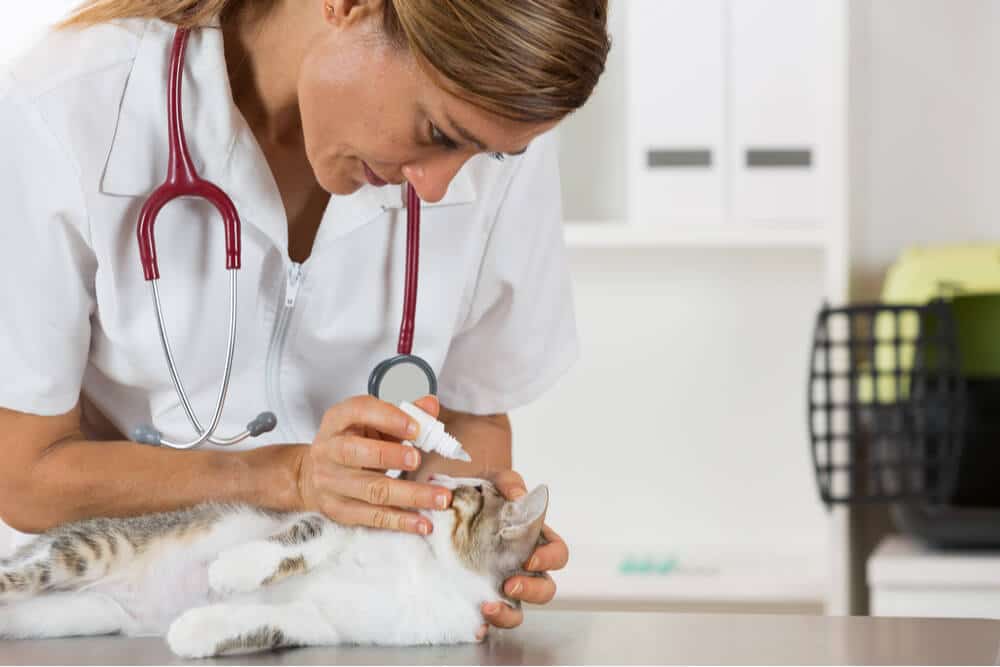
Have you noticed brown or reddish stained fur around your cat’s eyes? Does your cat seem to have watery ocular discharge that you need to wipe away frequently? They may have epiphora.
There are many causes of epiphora in cats. Some are completely benign, and some need treatment with the help of your veterinarian. Let’s discuss how to tell the difference and manage watery eyes, or epiphora.
Causes of Epiphora in Cats
Epiphora means excess lacrimation, or tear production. Your cat has tear glands around the eye and in the eyelids that produce a protective tear film.
This film keeps the surface of the eyeball lubricated and washes away debris or foreign objects. As your pet blinks, the tear film gets pushed across the surface of the eye, and then the excess tears drain away from the eye through a tube in the eyelid called the nasolacrimal duct. When any part of this system is out of balance, we see excessive tearing or epiphora.
Abnormal Anatomy
The way that tears normally exit the eye is through the lacrimal punctum. These are small openings, or holes, on the inner corner of the conjunctiva, or pink tissue around the eye.
These holes feed into a tube, the nasolacrimal duct, that goes from the conjunctiva to the nose. Then, tears drain down this tube into the nasal cavity and are absorbed and swallowed.
In some cats, tissue obstructs the puncta or the duct, leaving the tears no place to go. The tears then spill out onto the fur, causing wetness and sometimes staining. Abnormal nasolacrimal ducts form more commonly in breeds with short noses, or brachycephalic, such as Persians and Himalayans. If this is the problem, your veterinarian can open up the puncta and ducts, remove the blockage, and allow tears to flow properly.
Other abnormal anatomy triggering epiphora include conditions causing irritation. Entropion occurs when the eyelids, most commonly the lower eyelids in cats, roll in.
This causes irritation as the hair around the eye comes in contact with the surface of the eye, leading to excessive tearing. Surgical correction of entropion fixes the problem and can decrease pain and discomfort.
Distichia and ectopic cilia are two examples of eyelash disorders that cause epiphora. Distichia are hairs that grow in abnormal directions on the eyelid. Ectopic cilia are single hairs that grow through the conjunctiva toward the surface of the eye. As a result, both conditions cause irritation to the cornea and sclera, leading to epiphora.
Other Painful Diseases of the Eye

Cats with an infected eye will often squint and have eye discharge.
In addition to physical irritation by lashes, other diseases and injuries to the eye cause epiphora.
Corneal Injury
The cornea, or clear part of the eye, allows our cats to use their superior vision to hunt and socialize. The cornea is very sensitive.
Because a corneal injury is extremely painful, the feline body produces excess tears to respond to this pain, lubricating and protecting the cornea. A scratch to the cornea, or corneal ulcer, may result from a fight with another cat, running through brush, or an underlying medical condition such as dry eye.
With a corneal injury, you may notice your feline friend squinting along with epiphora and redness around the eye. This is an emergency, and a trip to your veterinarian is important. Your vet will administer pain medication to the surface of the eye and apply a special fluorescein stain to detect the ulcer. If found, eye drops to prevent infection and pain medication will get your kitty feeling better soon.
Dry Eye
Dry eye, or keratoconjunctivitis sicca, can lead to ulcers, and can even look like epiphora, too. How can dry eye look like excessive tearing? Several different molecules comprise tears, and sometimes the body produces the wrong combination.
This leads to dryness on the surface of the eye, but the body tries to make up for it, and we see excess eye goop or epiphora. Testing the true tear production will lead to a correct diagnosis and treatment.
Inflammation Around the Eye
Inflammation around they eye can also cause epiphora. Conjunctivitis is inflammation of the tissue around the eye, and can be caused by viruses like feline herpesvirus, bacterial infections, and allergic reactions. If the conjunctiva, becomes inflamed, your cat may need prescription eye drops or ointment to get back to normal.
Prominent Eyes
Some of our feline friends just have big, beautiful eyes and have anatomy that make their eyes prominent. The orbital rim, or bony socket, can be shallow in some breeds like Persians. Then, the eyelids are then in a position to catch fewer of the tears, which spill out onto the fur. In this case, the tear staining may not be true epiphora, but looks like it to their pet parent. If your cat’s eyes change in size or shape, call your vet immediately. Glaucoma is a disease that causes increased pressure in the eye and can lead to an enlarged eye, pain, and vision loss.
Treating Tear Stains

The appropriate treatment for tear stains depends on the severity of the epiphora. In mild cases, you may just need to keep the area dry and clean. It’s also important to treat the underlying cause of the epiphora.
If there is a medical condition causing the epiphora, treating the underlying cause is the first step. Work with your veterinarian to identify the problem. In some cases, a veterinary ophthalmologist referral will lead to the best treatment of severe or complicated conditions.
Keeping the Eye Area Clean and Dry
For mild cases or epiphora related to anatomy and breed, the most important thing is to keep the area around the eye clean and dry. This means getting your cat used to regular wiping around the face and eyes.
Pet parents should always use a clean, soft cloth when wiping around the face. Remember, do not use chemicals such as hydrogen peroxide, as they cause damage to the cornea and tissues around the eye. A cloth dampened with water is generally safe to use.
Medication

Conjunctivitis is defined by inflammation in and around the eye.
Excessive tearing used to be treated with certain antibiotics. This is not an appropriate treatment, as using sub-therapeutic, or low levels, of antibiotics can create resistance and make fighting infections harder in the future.
Excessive wetness of the skin and skin folds around the eye may lead to skin infections, or pyoderma. You may notice redness, swelling, and a foul odor around the face.
Your veterinarian can help determine if medication is needed. Do not apply human medications on or around the eyes. Cats are sensitive to ingredients in some medications and may have an adverse reaction.
Epiphora in cats is usually a benign condition. While requiring a bit more cleaning, the excessive tears do not generally cause harm. Be sure to have your feline friend examined by your vet if you have concerns.
Treating underlying conditions, such as blocked tear ducts or infections, will mean a quicker and more comfortable return to normal. Most importantly, do not apply medications or treatments around the eye without specific guidance. The eyes are one of the most sensitive, important, and beautiful parts of your pet.
Frequently Asked Questions
Why does the fur turn brown around the eye?
Tears contain compounds called porphyrins. When porphyrins are exposed to air, they change to a rust color. This can stain the fur where tears land. Sometimes the dried tears also turn brown. These compounds do not indicate infection or disease.
Is there a food or supplement I can give my cat to help with tearing and tear staining?
Some supplements claim to decrease tear staining, but they have no scientific basis and often do nothing. The best way to prevent the staining is to wipe the tears away frequently with a soft, dry cloth. Be careful not to touch the surface of the eye!
Does epiphora cause green or yellow discharge around the eye?
No, epiphora is just the over-production of normal tears. If you notice a different color discharge on or around the eye, your cat may have an infection. Call for a vet appointment as soon as possible.
How do you treat epiphora in cats?
There is not one specific treatment for epiphora. It is important to identify the underlying cause, such as abnormal eyelids, eye infection, or other diseases, in order to fix the problem.
How do you treat watery eyes in cats?
You can clean around the eyes with a damp or dry gentle cloth to remove excess moisture or tears. However, repeated tearing can indicate pain or an underlying problem, and your pet should be seen by a veterinarian to rule out infection.







